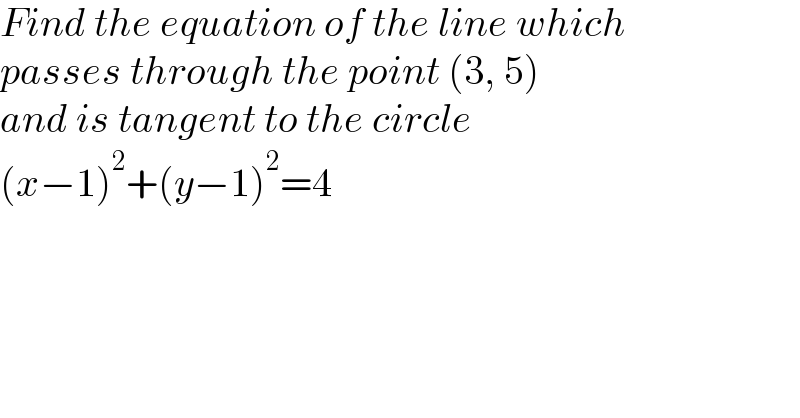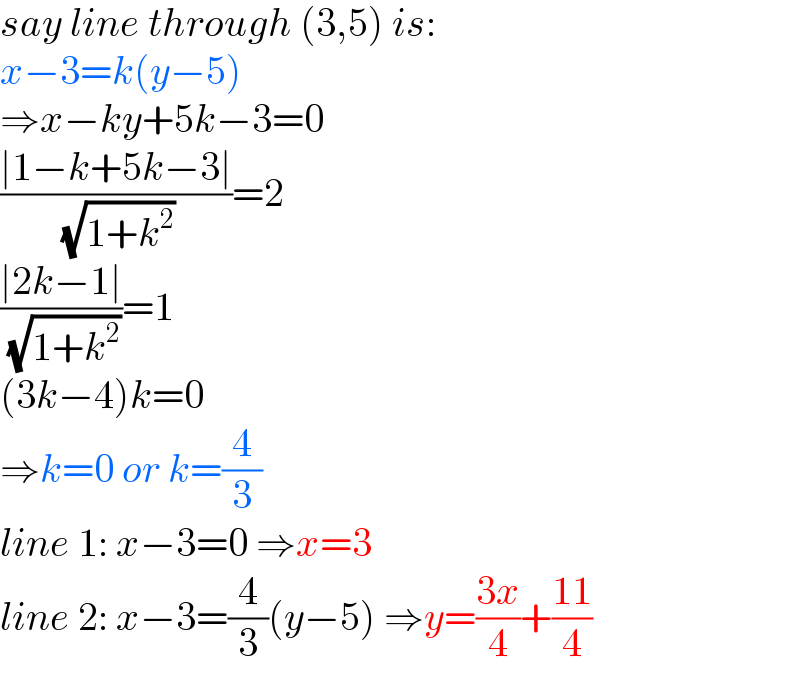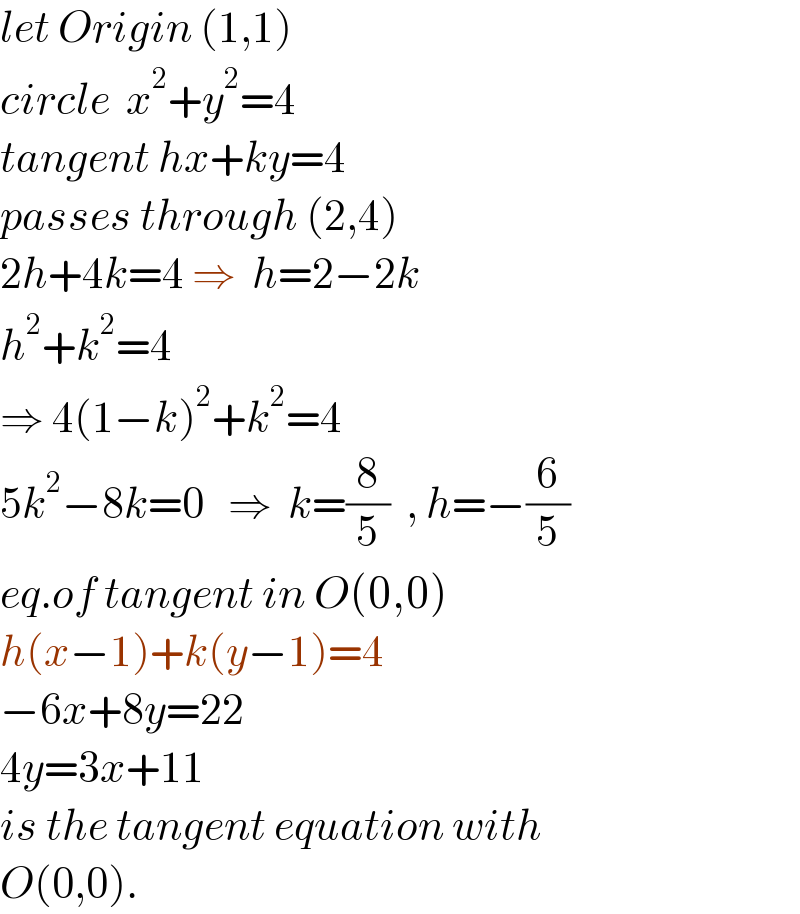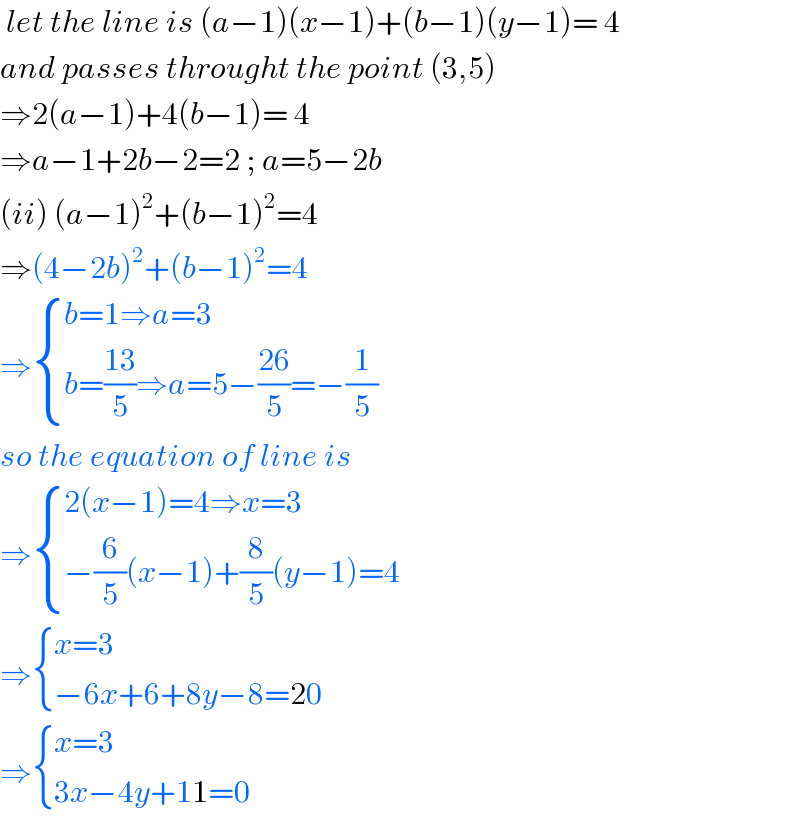
Question Number 183044 by depressiveshrek last updated on 19/Dec/22

$${Find}\:{the}\:{equation}\:{of}\:{the}\:{line}\:{which} \\ $$$${passes}\:{through}\:{the}\:{point}\:\left(\mathrm{3},\:\mathrm{5}\right) \\ $$$${and}\:{is}\:{tangent}\:{to}\:{the}\:{circle} \\ $$$$\left({x}−\mathrm{1}\right)^{\mathrm{2}} +\left({y}−\mathrm{1}\right)^{\mathrm{2}} =\mathrm{4} \\ $$
Answered by mr W last updated on 19/Dec/22

$${say}\:{line}\:{through}\:\left(\mathrm{3},\mathrm{5}\right)\:{is}:\: \\ $$$${x}−\mathrm{3}={k}\left({y}−\mathrm{5}\right) \\ $$$$\Rightarrow{x}−{ky}+\mathrm{5}{k}−\mathrm{3}=\mathrm{0} \\ $$$$\frac{\mid\mathrm{1}−{k}+\mathrm{5}{k}−\mathrm{3}\mid}{\:\sqrt{\mathrm{1}+{k}^{\mathrm{2}} }}=\mathrm{2} \\ $$$$\frac{\mid\mathrm{2}{k}−\mathrm{1}\mid}{\:\sqrt{\mathrm{1}+{k}^{\mathrm{2}} }}=\mathrm{1} \\ $$$$\left(\mathrm{3}{k}−\mathrm{4}\right){k}=\mathrm{0} \\ $$$$\Rightarrow{k}=\mathrm{0}\:{or}\:{k}=\frac{\mathrm{4}}{\mathrm{3}} \\ $$$${line}\:\mathrm{1}:\:{x}−\mathrm{3}=\mathrm{0}\:\Rightarrow{x}=\mathrm{3} \\ $$$${line}\:\mathrm{2}:\:{x}−\mathrm{3}=\frac{\mathrm{4}}{\mathrm{3}}\left({y}−\mathrm{5}\right)\:\Rightarrow{y}=\frac{\mathrm{3}{x}}{\mathrm{4}}+\frac{\mathrm{11}}{\mathrm{4}} \\ $$
Commented by mr W last updated on 19/Dec/22

Answered by MathAcer26 last updated on 19/Dec/22

$$\mathrm{The}\:\mathrm{center}\:\mathrm{is}\:\mathrm{at}\:\left(\mathrm{1},\mathrm{1}\right)\:\mathrm{with}\:\mathrm{radius}\:=\:\mathrm{2} \\ $$$$\left(\mathrm{3},\mathrm{1}\right)\:\mathrm{is}\:\mathrm{a}\:\mathrm{point}\:\mathrm{in}\:\mathrm{the}\:\mathrm{circle}. \\ $$$$\mathrm{Thus},\:\mathrm{x}\:=\:\mathrm{3}\:\mathrm{is}\:\mathrm{a}\:\mathrm{tangent}\:\mathrm{to}\:\mathrm{the}\:\mathrm{circle}\:\mathrm{passing} \\ $$$$\mathrm{through}\:\left(\mathrm{3},\mathrm{5}\right) \\ $$
Answered by ajfour last updated on 20/Dec/22

$${let}\:{Origin}\:\left(\mathrm{1},\mathrm{1}\right) \\ $$$${circle}\:\:{x}^{\mathrm{2}} +{y}^{\mathrm{2}} =\mathrm{4} \\ $$$${tangent}\:{hx}+{ky}=\mathrm{4} \\ $$$${passes}\:{through}\:\left(\mathrm{2},\mathrm{4}\right) \\ $$$$\mathrm{2}{h}+\mathrm{4}{k}=\mathrm{4}\:\Rightarrow\:\:{h}=\mathrm{2}−\mathrm{2}{k} \\ $$$${h}^{\mathrm{2}} +{k}^{\mathrm{2}} =\mathrm{4} \\ $$$$\Rightarrow\:\mathrm{4}\left(\mathrm{1}−{k}\right)^{\mathrm{2}} +{k}^{\mathrm{2}} =\mathrm{4} \\ $$$$\mathrm{5}{k}^{\mathrm{2}} −\mathrm{8}{k}=\mathrm{0}\:\:\:\Rightarrow\:\:{k}=\frac{\mathrm{8}}{\mathrm{5}}\:\:,\:{h}=−\frac{\mathrm{6}}{\mathrm{5}} \\ $$$${eq}.{of}\:{tangent}\:{in}\:{O}\left(\mathrm{0},\mathrm{0}\right) \\ $$$${h}\left({x}−\mathrm{1}\right)+{k}\left({y}−\mathrm{1}\right)=\mathrm{4} \\ $$$$−\mathrm{6}{x}+\mathrm{8}{y}=\mathrm{22} \\ $$$$\mathrm{4}{y}=\mathrm{3}{x}+\mathrm{11} \\ $$$${is}\:{the}\:{tangent}\:{equation}\:{with} \\ $$$${O}\left(\mathrm{0},\mathrm{0}\right). \\ $$
Answered by cortano1 last updated on 20/Dec/22

$$\:{let}\:{the}\:{line}\:{is}\:\left({a}−\mathrm{1}\right)\left({x}−\mathrm{1}\right)+\left({b}−\mathrm{1}\right)\left({y}−\mathrm{1}\right)=\:\mathrm{4} \\ $$$${and}\:{passes}\:{throught}\:{the}\:{point}\:\left(\mathrm{3},\mathrm{5}\right) \\ $$$$\Rightarrow\mathrm{2}\left({a}−\mathrm{1}\right)+\mathrm{4}\left({b}−\mathrm{1}\right)=\:\mathrm{4} \\ $$$$\Rightarrow{a}−\mathrm{1}+\mathrm{2}{b}−\mathrm{2}=\mathrm{2}\:;\:{a}=\mathrm{5}−\mathrm{2}{b} \\ $$$$\left({ii}\right)\:\left({a}−\mathrm{1}\right)^{\mathrm{2}} +\left({b}−\mathrm{1}\right)^{\mathrm{2}} =\mathrm{4} \\ $$$$\Rightarrow\left(\mathrm{4}−\mathrm{2}{b}\right)^{\mathrm{2}} +\left({b}−\mathrm{1}\right)^{\mathrm{2}} =\mathrm{4} \\ $$$$\Rightarrow\begin{cases}{{b}=\mathrm{1}\Rightarrow{a}=\mathrm{3}}\\{{b}=\frac{\mathrm{13}}{\mathrm{5}}\Rightarrow{a}=\mathrm{5}−\frac{\mathrm{26}}{\mathrm{5}}=−\frac{\mathrm{1}}{\mathrm{5}}}\end{cases} \\ $$$${so}\:{the}\:{equation}\:{of}\:{line}\:{is} \\ $$$$\Rightarrow\begin{cases}{\mathrm{2}\left({x}−\mathrm{1}\right)=\mathrm{4}\Rightarrow{x}=\mathrm{3}}\\{−\frac{\mathrm{6}}{\mathrm{5}}\left({x}−\mathrm{1}\right)+\frac{\mathrm{8}}{\mathrm{5}}\left({y}−\mathrm{1}\right)=\mathrm{4}}\end{cases} \\ $$$$\Rightarrow\begin{cases}{{x}=\mathrm{3}}\\{−\mathrm{6}{x}+\mathrm{6}+\mathrm{8}{y}−\mathrm{8}=\mathrm{20}}\end{cases} \\ $$$$\Rightarrow\begin{cases}{{x}=\mathrm{3}}\\{\mathrm{3}{x}−\mathrm{4}{y}+\mathrm{11}=\mathrm{0}}\end{cases} \\ $$
